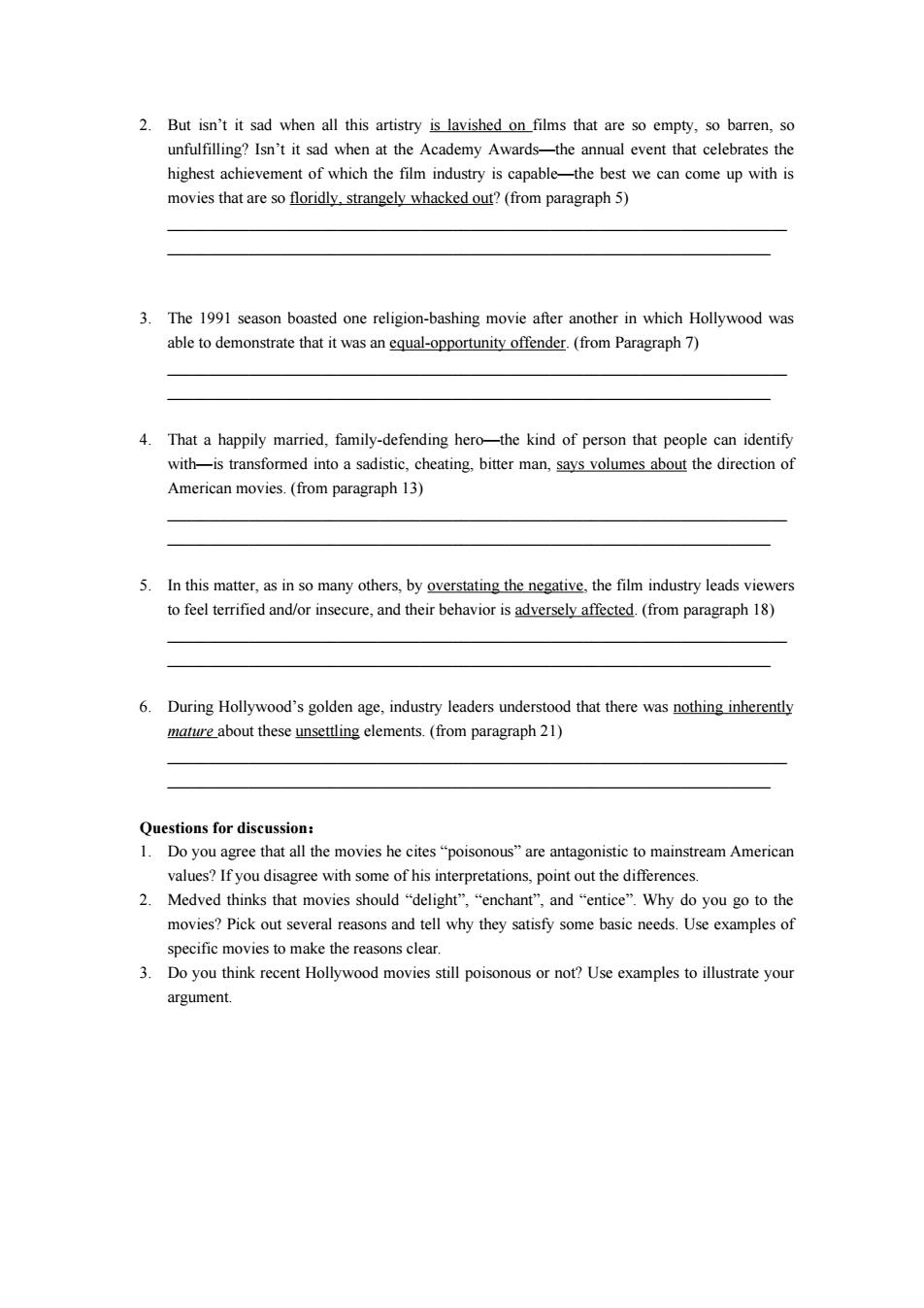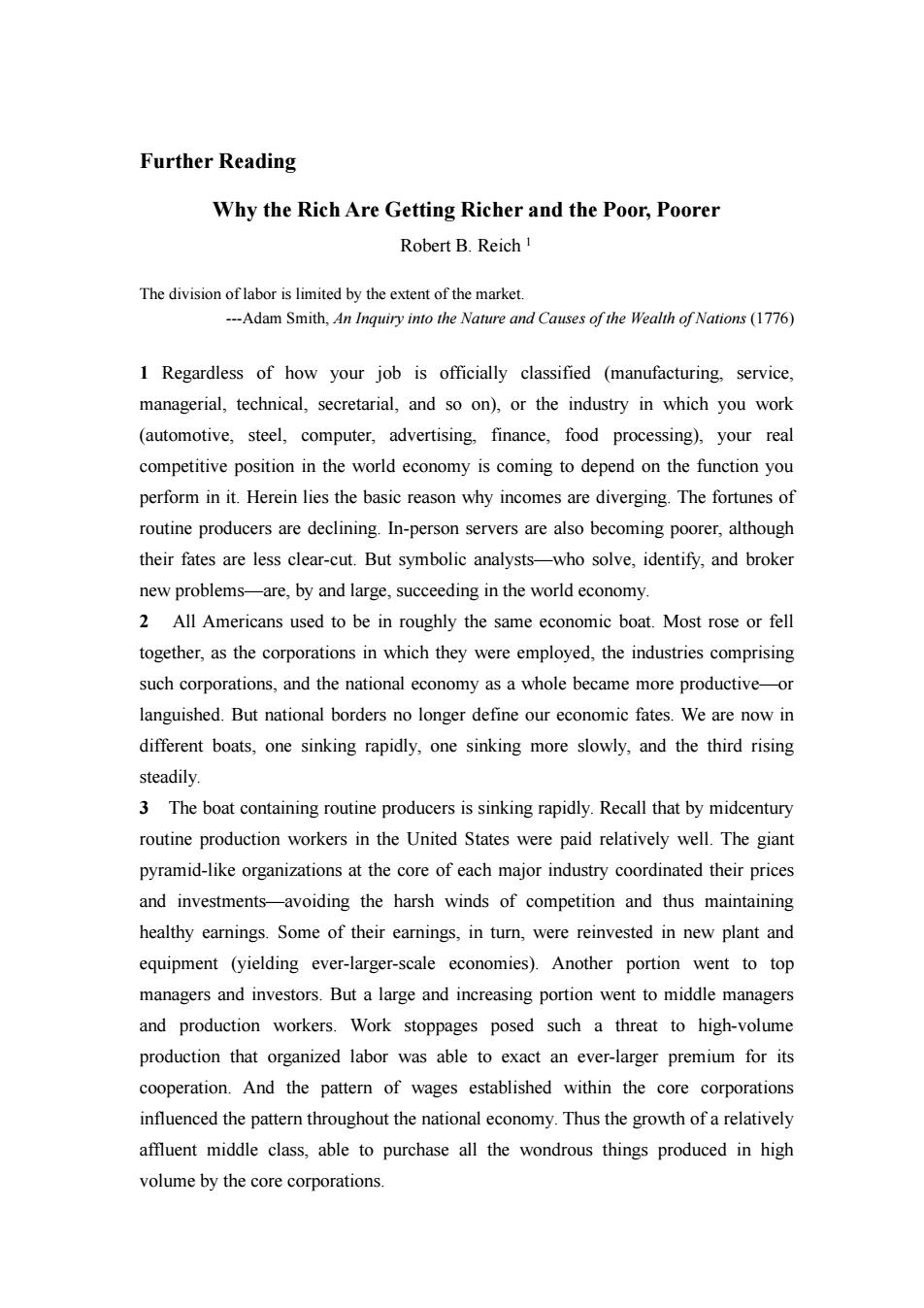
2.But isn't it sad when all this artistry is lavished on films that are so empty,so barren,so unfulfilling?Isn't it sad when at the Academy Awards-the annual event that celebrates the highest achievement of which the film industry is capable-the best we can come up with is movies that are so floridly,strangely whacked out?(from paragraph 5) 3.The 1991 season boasted one religion-bashing movie after another in which Hollywood was able to demonstrate that it was an equal-opportunity offender.(from Paragraph 7) 4.That a happily married,family-defending hero-the kind of person that people can identify with-is transformed into a sadistic,cheating,bitter man,says volumes about the direction of American movies.(from paragraph 13) 5.In this matter,as in so many others,by overstating the negative,the film industry leads viewers to feel terrified and/or insecure,and their behavior is adversely affected.(from paragraph 18) 6.During Hollywood's golden age,industry leaders understood that there was nothing inherently mature about these unsettling elements.(from paragraph 21) Questions for discussion: 1.Do you agree that all the movies he cites "poisonous"are antagonistic to mainstream American values?If you disagree with some of his interpretations,point out the differences. 2.Medved thinks that movies should“delight'”,“enchant'”,and“entice'”.Why do you go to the movies?Pick out several reasons and tell why they satisfy some basic needs.Use examples of specific movies to make the reasons clear. 3.Do you think recent Hollywood movies still poisonous or not?Use examples to illustrate your argument
2. But isn’t it sad when all this artistry is lavished on films that are so empty, so barren, so unfulfilling? Isn’t it sad when at the Academy Awards—the annual event that celebrates the highest achievement of which the film industry is capable—the best we can come up with is movies that are so floridly, strangely whacked out? (from paragraph 5) ____________________________________________________________________________ __________________________________________________________________________ 3. The 1991 season boasted one religion-bashing movie after another in which Hollywood was able to demonstrate that it was an equal-opportunity offender. (from Paragraph 7) ____________________________________________________________________________ __________________________________________________________________________ 4. That a happily married, family-defending hero—the kind of person that people can identify with—is transformed into a sadistic, cheating, bitter man, says volumes about the direction of American movies. (from paragraph 13) ____________________________________________________________________________ __________________________________________________________________________ 5. In this matter, as in so many others, by overstating the negative, the film industry leads viewers to feel terrified and/or insecure, and their behavior is adversely affected. (from paragraph 18) ____________________________________________________________________________ __________________________________________________________________________ 6. During Hollywood’s golden age, industry leaders understood that there was nothing inherently mature about these unsettling elements. (from paragraph 21) ____________________________________________________________________________ __________________________________________________________________________ Questions for discussion: 1. Do you agree that all the movies he cites “poisonous” are antagonistic to mainstream American values? If you disagree with some of his interpretations, point out the differences. 2. Medved thinks that movies should “delight”, “enchant”, and “entice”. Why do you go to the movies? Pick out several reasons and tell why they satisfy some basic needs. Use examples of specific movies to make the reasons clear. 3. Do you think recent Hollywood movies still poisonous or not? Use examples to illustrate your argument

Further Reading Why the Rich Are Getting Richer and the Poor,Poorer Robert B.Reich 1 The division of labor is limited by the extent of the market. ---Adam Smith,An Inquiry into the Nature and Causes of the Wealth of Nations(1776) 1 Regardless of how your job is officially classified (manufacturing,service, managerial,technical,secretarial,and so on),or the industry in which you work (automotive,steel,computer,advertising,finance,food processing),your real competitive position in the world economy is coming to depend on the function you perform in it.Herein lies the basic reason why incomes are diverging.The fortunes of routine producers are declining.In-person servers are also becoming poorer,although their fates are less clear-cut.But symbolic analysts-who solve,identify,and broker new problems-are,by and large,succeeding in the world economy. 2 All Americans used to be in roughly the same economic boat.Most rose or fell together,as the corporations in which they were employed,the industries comprising such corporations,and the national economy as a whole became more productive-or languished.But national borders no longer define our economic fates.We are now in different boats,one sinking rapidly,one sinking more slowly,and the third rising steadily. 3 The boat containing routine producers is sinking rapidly.Recall that by midcentury routine production workers in the United States were paid relatively well.The giant pyramid-like organizations at the core of each major industry coordinated their prices and investments-avoiding the harsh winds of competition and thus maintaining healthy earnings.Some of their earnings,in turn,were reinvested in new plant and equipment (yielding ever-larger-scale economies).Another portion went to top managers and investors.But a large and increasing portion went to middle managers and production workers.Work stoppages posed such a threat to high-volume production that organized labor was able to exact an ever-larger premium for its cooperation.And the pattern of wages established within the core corporations influenced the pattern throughout the national economy.Thus the growth of a relatively affluent middle class,able to purchase all the wondrous things produced in high volume by the core corporations
Further Reading Why the Rich Are Getting Richer and the Poor, Poorer Robert B. Reich 1 The division of labor is limited by the extent of the market. ---Adam Smith, An Inquiry into the Nature and Causes of the Wealth of Nations (1776) 1 Regardless of how your job is officially classified (manufacturing, service, managerial, technical, secretarial, and so on), or the industry in which you work (automotive, steel, computer, advertising, finance, food processing), your real competitive position in the world economy is coming to depend on the function you perform in it. Herein lies the basic reason why incomes are diverging. The fortunes of routine producers are declining. In-person servers are also becoming poorer, although their fates are less clear-cut. But symbolic analysts—who solve, identify, and broker new problems—are, by and large, succeeding in the world economy. 2 All Americans used to be in roughly the same economic boat. Most rose or fell together, as the corporations in which they were employed, the industries comprising such corporations, and the national economy as a whole became more productive—or languished. But national borders no longer define our economic fates. We are now in different boats, one sinking rapidly, one sinking more slowly, and the third rising steadily. 3 The boat containing routine producers is sinking rapidly. Recall that by midcentury routine production workers in the United States were paid relatively well. The giant pyramid-like organizations at the core of each major industry coordinated their prices and investments—avoiding the harsh winds of competition and thus maintaining healthy earnings. Some of their earnings, in turn, were reinvested in new plant and equipment (yielding ever-larger-scale economies). Another portion went to top managers and investors. But a large and increasing portion went to middle managers and production workers. Work stoppages posed such a threat to high-volume production that organized labor was able to exact an ever-larger premium for its cooperation. And the pattern of wages established within the core corporations influenced the pattern throughout the national economy. Thus the growth of a relatively affluent middle class, able to purchase all the wondrous things produced in high volume by the core corporations